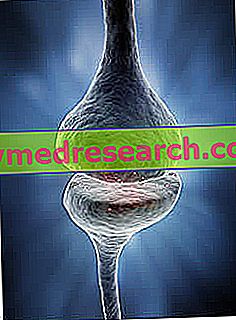Depression and neurotransmitters
Depression is a serious psychiatric condition that affects many people. It involves the mood, the mind and the body of the patients, who feel hopeless and feel a sense of desperation, of uselessness and incapacity.

Neurotransmitters are synthesized within the presynaptic nerve termination, stored in vesicles and, finally, released into the synaptic wall (the space present between the presynaptic and postsynaptic nerve termination) in response to certain stimuli.
Once released from the deposits, the monoamines interact with their receptors - both presynaptic and postsynaptic - in order to perform their biological activity.
In this way the transmission of the nerve impulse from one neuron to another is made possible.
After performing their function, the monoamines are picked up by specific transporters and brought back into the presynaptic nerve termination.
At this point, monoamine oxidases (or MAOs) intervene which are the enzymes responsible for the metabolism and degradation of monoamines .
Monoamine oxidase inhibitors (or MAOIs) are able to block these enzymes; in this way the concentration - consequently the activity - of monoaminergic neurotransmitters increases. This increase causes the depressive condition to improve.

History
The discovery of MAOIs was by chance, thanks to the development of derivatives of a drug used for the treatment of tuberculosis, isoniazid (nicotinic acid hydrazide).

Iproniazid - Chemical Structure
The first analogue of isoniazid to be synthesized was iproniazid . During the clinical trial phases of this derivative, a considerable improvement in mood was noted in patients suffering from tuberculosis. However, hyproniazide turned out to be hepato-toxic at the therapeutic doses necessary to obtain both an antitubercular and an antidepressant action.
The discovery of the antidepressant action of hyproniazide, however, gave impetus to the search for new monoamine oxidase inhibitors. This impulse led to the synthesis of hydrazine derivatives and non-hydrazine derivatives with lower toxicity than hyproniazide.
Classification
The classification of monoamine oxidase inhibitors can be made substantially in two ways.
The first subdivision is that which divides the IMAOs into:
- Hydrazine derivatives, such as phenelzine;
- Non-hydrazine derivatives, such as tranicylpromine, clorgiline and selegiline.
The second classification is that based on the selectivity or otherwise of the various isoforms of monoamine oxidases.
In fact, we know two MAO isoforms, monoamine oxidases type A (MAO-A) and type B (MAO-B).
MAO-A and MAO-B differ in their specificity towards certain substrates and due to the different distribution within the body's tissues. On the basis of this subdivision, we can therefore distinguish:
- Non-selective and irreversible MAO inhibitors, such as phenelzine and tranicylpromine;
- Selective and reversible MAO-A inhibitors, such as moclobemide;
- Selective and reversible MAO-B inhibitors, such as selegiline. However, this drug is not so much used in the treatment of depression, but in the therapy of Parkinson's disease which is characterized by a reduced central dopaminergic transmission, in nigrostriatal areas.
Action mechanism
Monoamine oxidases are enzymes mainly found in nerve tissues, liver and lungs.
Their task is to catalyze the oxidative deamination (ie the elimination of amino groups) of some endogenous substrates (monoamines), including adrenaline, noradrenaline, serotonin, dopamine, tyramine and phenylethylamine.
As mentioned, two isoforms of monoamine oxidases are known, MAO-A and MAO-B which differ in their specificity towards particular monoamines and for their distribution in different tissues.
- MAO-A are more selective for the metabolism of noradrenaline and serotonin.
- The MAO-B, on the other hand, show a greater selectivity for the metabolism of tyramine and dopamine.
The other monoamines are metabolised by both isoforms.
Regardless of the type of enzymatic isoform that is inhibited, the mechanism of action of MAOIs is always the same. These drugs are able to inhibit monoamine oxidases preventing metabolism and degradation of endogenous monoamines.
If the monoamines are not metabolized, their concentration increases; therefore, their biological activity also increases. This leads to an improvement in the depressive pathology.
However, before carrying out its pharmacological action, MAOIs may need a first latency period ranging from a few days to a few months.
On the other hand, once triggered, the antidepressant effect can last even weeks after stopping therapy.
Indications
For what it uses
MAOIs are indicated for the treatment of patients suffering from atypical depression and for the treatment of patients who do not respond to other drug therapies.
Today, monoamine oxidase inhibitors are rarely first-choice drugs.
MAOIs are also used as off-label drugs (ie drugs for which scientific evidence suggests their use even in pathologies not expressly indicated in the illustrative leaflet), in the treatment of:
- Bulimia, which has characteristics similar to atypical depression;
- Cocaine cessation (in particular, phenelzine is used);
- Nightmares;
- Post-traumatic stress disorder;
- In some forms of migraine, resistant to other therapies;
- Seasonal affective disorders;
- Panic attacks.
Interactions
The main interactions of irreversible MAOIs are above all those that are established with certain foods .
The ingestion of certain types of food - containing large amounts of tyramine and tryptophan - in combination with MAOI therapy, can in fact cause hypertensive crises due to the strengthening of the tyramine signal.
The severity and consequences of these interactions, however, vary from individual to individual; they can only be small increases in arterial blood pressure, or rapid and sharp increases in blood pressure. Patients who experience these effects, however, are more at risk of heart attack or brain bleeding.
Patients should avoid taking protein foods that may have undergone partial degradation as a result of aging, smoking, fermentation, pickling, and / or bacterial contamination. Among these foods we meet:
- Cheeses, such as - for example - Cheddar or Camembert;
- Spirits ;
- Fish preserved in vinegar ;
- Meat, such as - for example - smoked or spicy salami;
- Fruit, such as - for example - raisins;
- Dairy products and vegetables, such as yogurt, fermented extracts, pods and bean curd, soy sauce and avocado;
- Chocolate .
Patients receiving irreversible MAOIs must therefore pay close attention to their diet. In fact, the irreversible inhibition of hepatic and intestinal MAO-A causes the tyramine ingested with the diet not to be degraded, thus increasing its concentration and increasing the risk of hypertensive crisis.
The reversible MAO-A inhibitors, on the other hand, do not create very strong bonds with the enzyme and can easily be displaced by tyramine. For this reason, it is not necessary to impose diet restrictions in patients taking this type of medication.
MAOIs can also enhance the effect of drugs such as nasal decongestants, barbiturates, general anesthetics and sympathomimetic drugs.
Side effects
The main side effects of non-selective MAOIs are:
- agitation;
- Insomnia;
- Difficulty sleeping;
- Frequent nocturnal awakenings;
- Dizziness;
- Orthostatic hypotension (ie a sharp drop in blood pressure when passing from a lying or sitting position to an upright position);
- Dry mouth;
- Tremors, especially of arms and hands;
- Syncope;
- Palpitations;
- Tachycardia;
- Headache;
- Confusion;
- Excitation that can induce anxiety;
- Weakness;
- Gastrointestinal disorders;
- Constipation;
- Edema;
- Increased body weight;
- Sexual dysfunctions.



